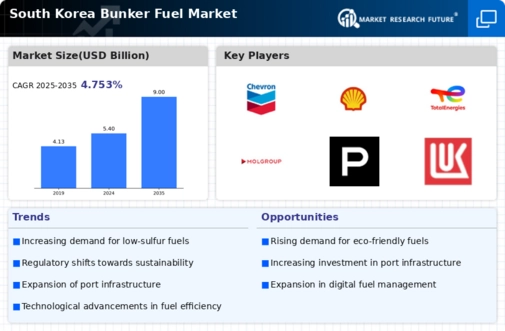The bunker fuel market in South Korea is characterized by a competitive landscape that is increasingly shaped by strategic innovation and operational efficiency. Key players such as Aegean Marine Petroleum Network (GR), Bunker Holding (DK), and Monjasa (DK) are actively pursuing growth through various strategies, including regional expansion and digital transformation. Aegean Marine Petroleum Network (GR) has focused on enhancing its supply chain capabilities, which appears to position the company favorably amidst rising demand for efficient fuel delivery. Meanwhile, Bunker Holding (DK) emphasizes sustainability in its operations, suggesting a shift towards greener fuel alternatives, which may resonate well with regulatory trends and customer preferences. Monjasa (DK) is also investing in digital solutions to streamline its operations, indicating a collective movement towards leveraging technology to enhance service delivery and operational transparency.
The business tactics employed by these companies reflect a moderately fragmented market structure, where localized strategies and supply chain optimization play crucial roles. The presence of multiple players fosters a competitive environment that encourages innovation and responsiveness to market demands. As companies localize their manufacturing and optimize their supply chains, they not only enhance their operational efficiencies but also contribute to a more resilient market structure that can adapt to fluctuations in demand and supply.
In October 2025, Aegean Marine Petroleum Network (GR) announced a strategic partnership with a local logistics firm to enhance its distribution network in South Korea. This move is likely to improve the company's operational efficiency and reduce delivery times, thereby strengthening its competitive position in a market that increasingly values speed and reliability. Such partnerships may also facilitate better compliance with local regulations, which is becoming a critical factor in the bunker fuel sector.
In September 2025, Bunker Holding (DK) launched a new line of low-sulfur fuel oil products aimed at meeting the stringent environmental regulations imposed by the International Maritime Organization (IMO). This initiative not only aligns with global sustainability trends but also positions Bunker Holding as a leader in the transition towards cleaner marine fuels. The strategic importance of this launch lies in its potential to capture market share from competitors who may be slower to adapt to these regulatory changes.
In August 2025, Monjasa (DK) unveiled a digital platform designed to enhance customer engagement and streamline the ordering process for bunker fuel. This platform is expected to provide real-time data on fuel availability and pricing, which could significantly improve customer satisfaction and loyalty. The strategic importance of this digital transformation lies in its ability to differentiate Monjasa from competitors, particularly in a market where technology adoption is becoming increasingly critical.
As of November 2025, the competitive trends in the bunker fuel market are heavily influenced by digitalization, sustainability, and the integration of advanced technologies such as AI. Strategic alliances are becoming more prevalent, as companies recognize the need to collaborate in order to enhance their service offerings and operational capabilities. Looking ahead, it appears that competitive differentiation will increasingly hinge on innovation and technology rather than solely on price. Companies that can effectively leverage technology to improve supply chain reliability and customer engagement are likely to emerge as leaders in this evolving landscape.




















Leave a Comment